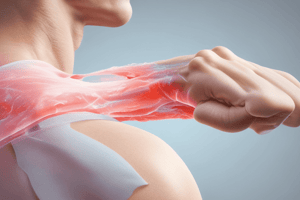Podcast
Questions and Answers
What is a key characteristic of the thawing stage in shoulder rehabilitation?
What is a key characteristic of the thawing stage in shoulder rehabilitation?
- Return of motion (correct)
- Significant loss of motion
- Complete restoration of normal function
- Return of normal capsular volume
Why should aggressive stretching be avoided in the rehabilitation of diabetic patients?
Why should aggressive stretching be avoided in the rehabilitation of diabetic patients?
- It can cause inflammation in the joint
- It does not significantly improve range of motion (correct)
- It may lead to a complete loss of motion
- It can damage muscle fibers
What initial treatment strategy is recommended during the thawing stage?
What initial treatment strategy is recommended during the thawing stage?
- Performing heavy weight lifting
- Using only soft tissue techniques
- Mobilizing the scapula gently (correct)
- Aggressive joint manipulation
Which muscles should be targeted with soft tissue techniques to reduce tension before stretching?
Which muscles should be targeted with soft tissue techniques to reduce tension before stretching?
What is advised regarding the movement of the clavicle during treatment?
What is advised regarding the movement of the clavicle during treatment?
What is the primary focus of treatment during the freezing stage of shoulder rehabilitation?
What is the primary focus of treatment during the freezing stage of shoulder rehabilitation?
Which technique is recommended for pain modulation during the painful stage?
Which technique is recommended for pain modulation during the painful stage?
In which stage of shoulder rehabilitation do patients typically experience minimal pain but demonstrate a limitation of motion?
In which stage of shoulder rehabilitation do patients typically experience minimal pain but demonstrate a limitation of motion?
What exercise is suggested for patients to help facilitate return to sleep if awakened by pain during the freezing stage?
What exercise is suggested for patients to help facilitate return to sleep if awakened by pain during the freezing stage?
Which statement about the treatment of the frozen stage is true?
Which statement about the treatment of the frozen stage is true?
What is a characteristic symptom of adhesive capsulitis?
What is a characteristic symptom of adhesive capsulitis?
What is the typical age range for the onset of adhesive capsulitis?
What is the typical age range for the onset of adhesive capsulitis?
Which condition is particularly associated with adhesive capsulitis?
Which condition is particularly associated with adhesive capsulitis?
Which phase is NOT part of the natural progression of adhesive capsulitis?
Which phase is NOT part of the natural progression of adhesive capsulitis?
What is the expected duration before adhesive capsulitis typically resolves spontaneously?
What is the expected duration before adhesive capsulitis typically resolves spontaneously?
Which of the following is a diagnostic criterion for adhesive capsulitis?
Which of the following is a diagnostic criterion for adhesive capsulitis?
What may happen to shoulder movement after recovery from adhesive capsulitis?
What may happen to shoulder movement after recovery from adhesive capsulitis?
What common misconception exists regarding the stiffness that develops with adhesive capsulitis?
What common misconception exists regarding the stiffness that develops with adhesive capsulitis?
Flashcards
Frozen Stage Treatment
Frozen Stage Treatment
Focuses on strengthening exercises within the patient's available range of motion (ROM). Manipulation may be possible.
Pain Modulation Techniques
Pain Modulation Techniques
Gentle distractions, TENS (transcutaneous electrical nerve stimulation), or other methods to control pain.
Codman Exercises
Codman Exercises
Supporting a flexed arm, raising it forward with the opposite hand. Helps restore range of motion.
Freezing Stage Treatment
Freezing Stage Treatment
Signup and view all the flashcards
Sleep Disturbances Treatment
Sleep Disturbances Treatment
Signup and view all the flashcards
Thawing Stage
Thawing Stage
Signup and view all the flashcards
Aggressive Stretching
Aggressive Stretching
Signup and view all the flashcards
ROM Maintenance
ROM Maintenance
Signup and view all the flashcards
Diabetic Patients
Diabetic Patients
Signup and view all the flashcards
Scapula Mobilization
Scapula Mobilization
Signup and view all the flashcards
Frozen Shoulder
Frozen Shoulder
Signup and view all the flashcards
Clinical Feature (Frozen Shoulder)
Clinical Feature (Frozen Shoulder)
Signup and view all the flashcards
Diagnosis (Frozen Shoulder)
Diagnosis (Frozen Shoulder)
Signup and view all the flashcards
Differential Diagnosis (Frozen Shoulder)
Differential Diagnosis (Frozen Shoulder)
Signup and view all the flashcards
Associated Conditions
Associated Conditions
Signup and view all the flashcards
X-rays (Frozen Shoulder)
X-rays (Frozen Shoulder)
Signup and view all the flashcards
Shoulder Pain
Shoulder Pain
Signup and view all the flashcards
Stiffness (Frozen Shoulder)
Stiffness (Frozen Shoulder)
Signup and view all the flashcards
Study Notes
Adhesive Capsulitis (Frozen Shoulder)
- A well-defined disorder causing progressive pain and stiffness in the shoulder
- Symptoms usually resolve spontaneously after about 18 months
- Cause is unknown
- Associated with conditions like diabetes, Dupuytren's disease, hyperlipidemia, hyperthyroidism, cardiac disease, and hemiplegia
- Can sometimes occur after recovery from neurosurgery
Clinical Features
- Patients are typically aged 40-60
- Often preceded by a history of (sometimes minor) trauma
- Pain gradually increases in severity, preventing sleeping on the affected side
- Pain subsides after several months, but stiffness typically persists for another 6-12 months
- Movement may return but not always to full normal range, and some pain may persist
- Active and passive movement is limited in all directions
Diagnosis
- Characterized by painful restriction in movement despite normal X-rays
- Follows a natural progression through three phases
Treatment
- Analgesics and anti-inflammatory drugs
- Physical therapy and rehabilitation
- Manipulation under general anesthesia
Physical Therapy
- Painful Stage: Use pain modulation techniques (e.g., TENS), and avoid aggressive stretching exercises. Patients position themselves to minimize the affected limb use. Instead of passive postures, ask patients to involved the unaffected arm to support the affected arm. Codman and posture exercises may be used.
- Freezing Stage: Focus on maintaining the current range of motion. Gentle extension, within the available range, is necessary but avoiding reaching the limit of motion. The use of pillows or thoracic positioning may be recommended to promote sleep. No aggressive stretching or resistance exercises should be performed. Encourage patients to "climb the wall" in the scapular plane
- Frozen Stage: Patients demonstrate motion limitation, but pain is minimal. Exercise and range of motion work within end-range are encouraged, as well as strengthening exercise. Manipulations can be used at this stage.
- Thawing Stage: Return of motion is a hallmark, but capsular volume is often not restored. Variety of stretching maneuvers may be effective. Treatments for this stage include mobilizing the scapula-move the scapula over the fingers, mobilize the clavicle, and soft tissue techniques like those on rotators, pectoral muscle, etc.
Differential Diagnosis
- In patients with diabetes, signs of inflammation may be absent during the initial stages
- Severe shoulder injury may cause stiffness, but usually pain gradually lessens
- The pattern of pain and stiffness following a forearm fracture differs from a typical frozen shoulder
Important Considerations
- Patients with diabetes may have a less favorable response to manipulation, even in the frozen stage
- Aggressive stretching is not recommended during the early stages
Studying That Suits You
Use AI to generate personalized quizzes and flashcards to suit your learning preferences.



